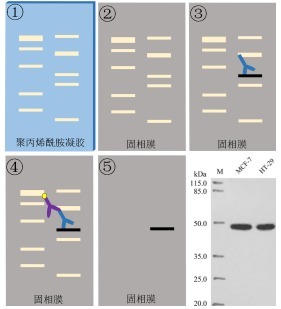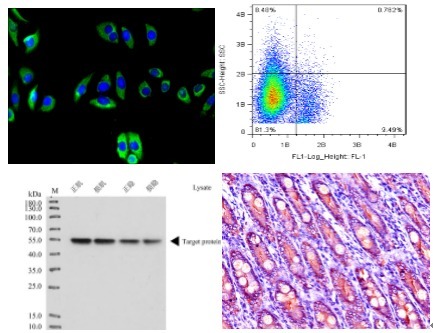[Protein research series topic] -10 丨WB detection of antibodies, have you chosen the right one?
WB immunoblotting , also known as immunometabolization technique IBT (Immunoblotting), is an immunological detection method in which Towbin applied the Southern blotting technique invented by Southern in 1975 to the establishment of protein-protein interaction. It is easy to operate and is mainly used for the detection of unknown proteins and the identification of antigen components and antigenic determinants. It is also used for the detection of unknown antibodies and the identification of monoclonal antibodies. It is used in basic biological research and early diagnosis and prognosis analysis of clinical diseases. There are applications. The basic principle of WB detection is not described in detail, and can be supplemented according to the following pictures:

There are three antibodies used in the WB experiment: primary antibody, secondary antibody and internal reference antibody. The primary antibody is the only antibody against the target antigen, which can be prepared or purchased in stock, and the difficulty coefficient is high; the second antibody is directly purchased, but it is necessary to pay attention to the selection of the next species; the internal reference antibody is essential and is the quality in the WB experiment. Control link.
So, are the babies very tangled when preparing antibodies or selecting antibodies? Today, Xiaobian talks to you.
WB detection one of the resistance
Primary antibody preparation
If the spot antibody of the target protein is not found , or if you don't like it, you need to prepare it yourself. Please help the company do it well! Prepare the primary antibody by yourself. Usually, mice or rabbits can be selected to prepare polyclonal antibodies or mice can be used to prepare monoclonal antibodies. The former saves time and money, while the latter consumes time and money but has advantages and disadvantages. Multi-anti-preparation is easy to produce miscellaneous bands, but it is easy to produce results. Monoclonal antibody preparation can get a single strip and a beautiful WB picture. It is also good to show off. However, if there is no strong cell culture, fusion, and screening experience, there are various unexpected results. For example, if you fail, or you can only screen one, you can't do WB. However, attention to detail in each step of the experiment can still obtain satisfactory antibodies.
Multi-resistance preparation process:
The first step: immune and potency testing. It seems that only the antigen is put into the animal body, in fact, hidden mystery, different immune methods have different effects. Usually, the immune effect is sorted as follows: intradermal > subcutaneous > abdominal cavity > vein, usually by intradermal or subcutaneous immunization. Immune tolerance is produced by too much immunization dose. Generally, mice are immunized with 50 μg for 4 times each time, and rabbits are immunized with 300-500 μg for 5 times each time. A control should be set for the titer after each immunization to rule out ELISA false positives or false negatives caused by various conditions.
The second step: take blood. Mice taking blood usually take blood from the eyeball, and one mouse can get about 1.5 mL of antiserum. Rabbit blood is usually taken from the carotid artery, and a rabbit can get about 25 mL of antiserum.
The third step: antibody purification. The purification of the monoclonal antibody can be carried out using proteinA/G, and all of the obtained antibody molecules are uniform. Purification of polyclonal antibodies can be performed by proteinA/G or antigen affinity purification. The latter screens out some non-specific IgGs, leaving antibodies that bind to the antigen, so it can avoid the mismatch of WB results to some extent. problem.
Monoclonal antibody preparation process:
Step 1: Refer to the first step of preparation of the polyclonal antibody.
The second step: cell fusion. The cells are very fragile in the process of fusion, so the strength should be light and the time should be well controlled. Generally, according to the standard fusion scheme, it is possible to draw a circle with one hand and draw a circle with one hand. This step needs to learn from Guo Jingtong shoes. Basically, you can see a lot of rounded monobodies in the fusion plate.
The third step: subcloning. Basically, programmatically, don't be too embarrassed to blow the cells.
The fourth step: screening test. Cell supernatants should be screened and detected after cell fusion and subcloning. Cell monoclones are susceptible to judgment during growth due to the fact that external forces are scattered into irregular shapes, and perhaps a good positive clone is thus ignored. So don't let your board get in, especially when the fusion cell plate is changing fluid. Of course, if you don't bother, you can pick the monoclonal plate of the fusion plate and test it on the new cell plate.
The fifth step: ascites preparation. The selected positive monoclonal antibody cell line was injected into the peritoneal cavity of the mouse, and the ascites containing the high concentration of monoclonal antibody was produced in the abdominal cavity of the mouse over a period of time. The number of cells injected should not be too much or too little. Too little will result in no ascites or excessive cycle, and too much will lead to premature death in mice. Generally, a mouse can be intraperitoneally injected with 10^6 cells, and ascites can be taken in about 2 weeks.
Step 6: Refer to the third step of preparation of the polyclonal antibody.

Primary antibody selection
If you have the stock, you don't have to spend time and energy to prepare yourself. Come and get the spot one to choose new skills!
1 The specification of the antibody clearly indicates that it is preferred for WB detection. But if you don't write, it means you can't do it. Maybe the manufacturer hasn't verified it. If you really need this or only this one, you can apply for a trial installation from the manufacturer.
2 The species to which the antibody is applied is also considered. The instructions will also state that if the source species of the study sample is not on the list, it does not mean that it cannot be used, but it is best not to use it. Of course, the applicability of antibodies is related to the sequence similarity of different proteins in different species. Informatic methods can be used to predict whether antibodies are available. If the homology is high, it is still optional.
3 antigen types also need to be reviewed. The immunogen is not limited to a protein, and the cells or cells can be used as immunogens, and distinctions should be made at the time of selection. For example, to detect a segment or isoform of a protein, an antibody prepared using an immunogen containing the fragment domain is selected.
4 If the primary antibody is unlabeled and a secondary antibody is required, the selected primary antibody source species and the sample source species should be avoided to cause cross-reactivity. For example, when detecting a protein of interest in a rat tissue, it is preferable to select a rabbit anti-mouse primary antibody instead of a mouse-derived primary antibody. If the primary antibody is labeled, then this problem can be ignored.
Medical Equipment,Medical Dental Unit,Dental Medical Equipment,Medical Dental Equipment
ZHEJIANG FOMOS MEDICAL TECHNOLOGY CO.,LTD. , https://www.ifomos.com